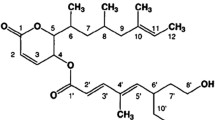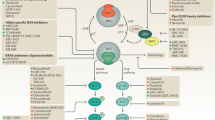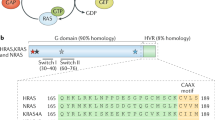Background and Purpose:
Ras has been identified as a significant contributor to radiation resistance. This article reviews preclinical and phase I clinical studies that reported on combining inhibition of activated Ras and downstream effectors of Ras with radiotherapy.
Material and Methods:
Transfection studies and RNA interference were used to check the role of the Ras isoforms for intrinsic radiation sensibility. Western blotting was used to control for prenylation inhibition of the respective Ras isoforms and for changes in activity of downstream proteins. Clonogenic assays with human and rodent tumor cell lines served for testing radiosensitivity. In vivo, farnesyltransferase inhibitors (FTIs) and irradiation were used to treat xenograft tumors. Ex vivo plating efficiency measurements, regrowth of tumors, and EF5 staining for detection of hypoxia were endpoints in these studies. Simultaneous treatment with L-778,123 and irradiation was performed in non-small cell lung cancer, head and neck cancer, and pancreatic cancer patients.
Results:
Radiation sensitization was achieved in vitro and in vivo blocking the prenylation of Ras proteins in cell lines with Ras activated by mutations or receptor signaling. Among the many Ras downstream pathways the phosphoinositide 3 (PI3) kinase-Akt pathway was identified as a contributor to Ras-mediated radiation resistance. Furthermore, increased oxygenation was observed in xenograft tumors after FTI treatment. Combined treatment in a phase I study was safe and effective.
Conclusion:
The rational combination of FTIs with radiotherapy may improve the clinical results of patients with tumors who bear mutant or receptor-signaling activated Ras.
Hintergrund und Ziel:
Ras wurde als signifikanter Faktor der Strahlenresistenz erkannt. Dieser Artikel gibt einen Überblick über präklinische Studien und klinische Phase-I-Studien zur kombinierten Inhibierung von aktiviertem Ras und von Ras-Effektoren mit Radiotherapie.
Material und Methodik:
Transfektionsstudien und RNA-Interferenz kamen zur Anwendung, um die Rolle der Ras-Isoformen für die intrinsische Radiosensibilität zu untersuchen. Westernblots dienten der Kontrolle der Prenylierungsinhibierung der jeweiligen Ras-Isoformen und dem Screening von Änderungen der Aktivität von Downstream-Proteinen. Koloniebildungstests mit humanen und Nagertumorzelllinien wurden zur Testung der Radiosensitivität durchgeführt. In vivo wurden Farnesyltransferaseinhibitoren (FTIs) und Bestrahlung für die Behandlung von Xenografttumoren verwendet. Ex vivo waren Messungen der Platierungseffizienz, des Nachwachsens von Tumoren und der EF5-Färbung für die Detektion von Hypoxie Endpunkte dieser Studien. Patienten mit nichtkleinzelligem Bronchialkarzinom, Kopf-Hals-Tumoren und Pankreaskarzinom wurden simultan mit L-778,123 und Radiotherapie behandelt.
Ergebnisse:
Strahlensensibilisierung wurde in vitro and in vivo nach Blockade der Prenylierung von Ras-Proteinen in Zelllinien mit Ras-Aktivierung durch Mutationen oder Rezeptorsignalaktivität erreicht. Unter den vielen Ras-Downstream-Signalwegen wurde die Bedeutung des Beitrags des Phosphoinositol-3-(PI3-)Kinase-Akt-Weges zur Strahlenresistenz identifiziert. Des Weiteren wurde nach FTI-Behandlung bei Xenografttumoren eine gesteigerte Oxygenierung beobachtet. Die Kombinationsbehandlung war in einer Phase-I-Studie sicher und wirksam.
Schlussfolgerung:
Die Kombination von FTIs mit Bestrahlung ist ein Ansatz, der die klinischen Ergebnisse von Patienten mit Tumoren verbessern könnte, bei denen Ras mutiert oder über Rezeptorsignale aktiviert ist.
Similar content being viewed by others
Author information
Authors and Affiliations
Corresponding author
Additional information
This paper is dedicated to Professor Rolf Sauer, MD, chair of the Department of Radiation Oncology, University of Erlangen, on the occasion of his 65th birthday.
Rights and permissions
About this article
Cite this article
Brunner, T.B., Hahn, S.M., McKenna, W.G. et al. Radiation Sensitization by Inhibition of Activated Ras. Strahlenther Onkol 180, 731–740 (2004). https://doi.org/10.1007/s00066-004-9198-8
Issue Date:
DOI: https://doi.org/10.1007/s00066-004-9198-8




